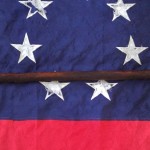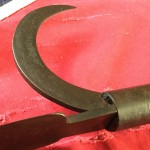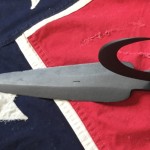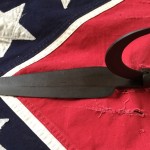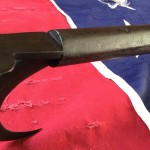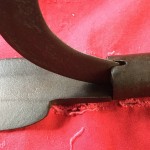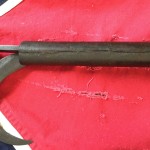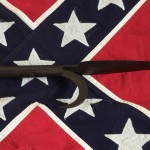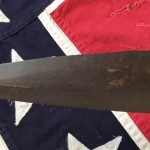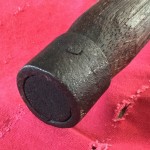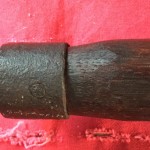- Confederate Bridle Cutter Pike
- Louis Froelich, Confederate Sickle Pike
- Bridle Cutter and Lance Blades
- Bridle Cutter Sickle and Blade
- Pike Iron Sleeve, Closeup
- Sickle and Blade, Closeup
- Confederate Lance, Iron Shaft Collar
- Louis Froelich Lance, Bridle Cutter
- Confederate Lance Blade, Louis Froelich
- Loius Froelich, Pike End Cap
- Bridle Cutter End Cap
The second type of lance was similar to the first with the addition of a sickle shaped bridle cutter. The sickle and the blade are actually two different pieces held in place with the 6 ¾” iron collar. This primitive type of weapon would have been used against Calvary troops charging artillery batteries.
If the user could hook the sickle portion of the blade around the leather bridle portion of the charging Calvary Horsemen they would cut the bridle leaving the rider of the horse with no control and vulnerable to attack from foot soldiers. I’m not certain of any documented use of these weapons but it doesn’t mean they weren’t used in rare instances. By the time of the American Civl War, most of these types of Napoleonic weapons were obsolete…..remember Calvary-men had breach loading carbines such as Sharps and Spencer’s that could shoot up to 7 shots before reloading.
Exactly how many lances and bridle cutters were made by Louis Froelich and Company is not known, but extant examples are extremely rare. An article in the “Home Industry” April 28th, 1864 edition of the Wilmington Journal reported that Froelich manufactured 3,700 lance spears during the war. It’s not clear how many of the 3,700 were bridle cutters but it’s the authors opinion that it’s few at best. As of this blog post there are only 7 Louis Froelich bridle cutters know to exist.
Which brings us to the newest weapon in the Civil War Arsenal. Over the past year or so I’ve been on a mission to grow my collection of Confederate poles of all types….Pikes, Lances, Bridle Cutters and Flagstaffs. They make great conversation pieces and display nicely in my War Room/Arsenal. Most collectors like the guns and edged weapons (I do too) but don’t normally collect pole type weapons. Probably because there hard to display, due to there size and even though they were made during the war not many were used during in battle……and many collectors want weapons that have provenance, not pieces that sat in arsenals waiting to be used.
This Bridle Cutter is in great condition, it’s hickory shaft has no cracks and the iron has a nice darkened patina to it. It even has its iron collar at its base which is usually missing on other pikes and lances. Just another great piece of American history with North Carolina provenance, you gotta love the South.
I’d like to thank John W. McAden, Jr. and Chris E. Fonvielle, Jr., there book “Louis Froelich Arms-Maker to the Confederacy”. Without collectors and enthusiasts like them we would know little about the history of pieces like this.
If you have any questions about this Bridle Cutter or any of the other pieces in the Civil War Arsenal feel free to contact me at civilwararsenal@yahoo.com attn: Gene West

